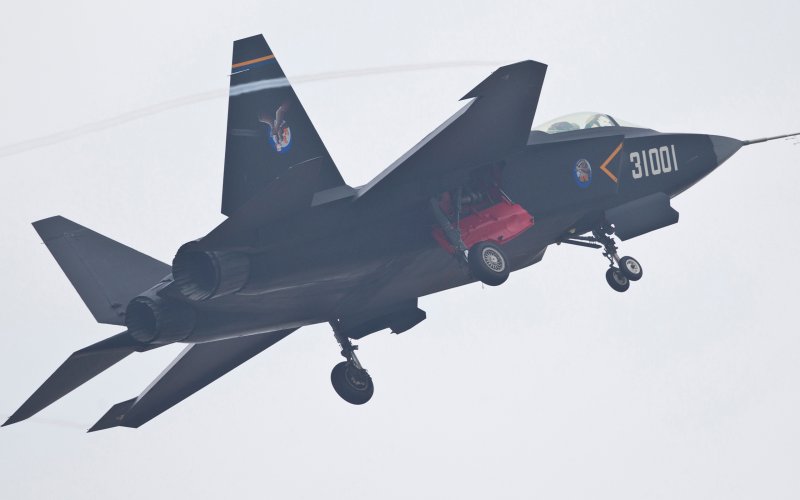Much Ado About China’s J-31 Gyrfalcon Stealth Fighter
China’s second stealth fighter the J-31 “Gyrfalcon” (or “Falcon Hawk”, “Falcon Eagle”) became the star attraction at the 10th Zhuhai Airshow China fair that just closed over the weekend. Leading up to the show, particularly the US media and officialdom had poo-pooed its debut, attacking it as an unworthy knock-off of the US F-35 Joint Strike Fighter, the core technologies and design of which were stolen from a subcontractor of Lockheed Martin through cyber attacks.
Interestingly, however, a National Post commentary by an otherwise China critic was somewhat conciliatory, quoting an expert friend of his as saying stealing aircraft and rocket designs is an ‘old business’ “that when done right can work wonders for the country playing catch-up. Look at the US ballistic missile and space programs, which got a 10 to 15 year leap from the V2 rockets and the German scientists who came with it.”
He also notes there is a consensus among Western leaders that, in contrast to their Russian counterparts who had in the day borrowed passenger airliner designs from the West, Chinese engineers are more likely to be able to replicate (and even surpass) Western levels of quality and sophistication. Moreover, the Chinese can pour in a lot of financial resources and manpower to make sure it is done right. (The success of China’s high speed rail locomotives and vast rail network is a case in point.)
Regardless of whether acquired through cyber espionage or indigenously developed or a combination of both, the Chinese have successfully designed and built a 5th stealth fighter that will be formidable for foreign air forces and navies to contend with. Sun Cong, chief designer of the J-31, told the Xinhua News Agency he anticipates the fighter will eventually be paired with the bigger and more technologically mature J-20 that debuted a year earlier and become China’s next generation carrier-borne jet, along the lines of the US’s F-35C.
Its demonstration flight at the air show also indicates it is intended for export. The Zhuhai show drew about 700 companies from all over the world eager to show off their stuff and make deals. Aerial expert John Stillion said to Inquisitr News, “the more ambitious the display, probably the closer it is being ready for prime time. If they fly it, that’s a big deal. One of the ways countries try to increase demand for their combat aircraft is displaying them, doing cool stuff at air shows; it’s an opportunity to show off.”
Huanqiu.com, a major news portal in China, quoted sources from J-31 manufacturer Aviation Industry Corp of China (AVIC) that some “traditional buyers” of Chinese aircraft had expressed “great interest” in the fighter. Foreign analysts speculate Pakistan will be first in line followed by Bangladesh and Myanmar. After that, potentially Iran and various Gulf, African, South American, and even Southeast Asian states could be waiting. It is very doubtful if any will be offered to North Korea or Vietnam even if they have the hard cash because of Korean peninsula nuclear and South China Sea territorial dispute concerns.
The New York Times figures the J-31 will go for between US$75 to $100 million a piece, vastly cheaper than the J-35 Lightning II whose going price has sky-rocketed to a whopping $200 million (and more for the Japanese market) and even the presumably more reasonably priced Russian Sukhoi T-50. Chinese military analysts on a recent CCTV 4 Focus Today programme concurred it would be substantially lower than the $100 million mark, making it affordable for many developing countries.
Although the Western media assumes the basic design to be stolen, they nonetheless nitpick and conjecture about the J-31’s design and performance faults. One big issue is the continued use of Russian-made engines which, in the case of a J-31 prototype, is the Klimov RD-93. But, China has already developed an indigenous design similar to the Russian and improving it with greater thrust for fitting on future J-31s. With greater capabilities and confidence, military analysts suggest Chinese makers may be able to power the J-31 with domestic engines faster than for the J-20 and in greater quantities.
A IHS Jane’s Defence Weekly correspondent writing on CNN, observing the J-31’s flight routine, said the plane “bleeds” too much energy leading to altitude loss when entering turns, deemed a aerodynamic design drawback. Moreover, the J-31 flew “clean” meaning that it was not armed. On real missions loaded with weapons, the plane would be heavier and therefore could perform even worse. Chinese jet fighter aficionados and netizens further point out the J-31’s exhaust appeared darker, suggesting perhaps the engine wasn’t burning fuel efficiently.
But, questioned about possible design flaws of the J-31, Vladimir Barkovsky, a prominent designer with Russian Aircraft Corporation MiG, stated in spite of some imperfections, the J-31 “looks like a good machine”. And although it incorporated certain features already in use on 5th generation US fighter designs, the J-31 “is not a copy but a well done indigenous design.”
Interviewed by US Naval Institute News (USNI News), a senior US naval officer predicted China will eventually perfect the J-20 and J-31 – it is just a matter of time. “They are going to get there one day, make no mistake. It won’t be tomorrow or the next day but the fact this place (Zhuhai) is debuting now should tell you something about China’s commitment”, he said.


0 Comments
Trackbacks/Pingbacks